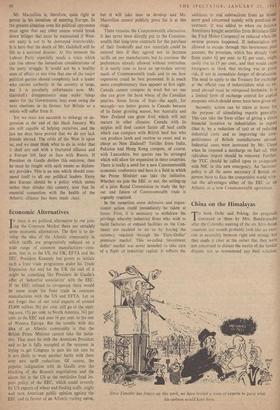China on the Himalayas
To both Delhi and Peking, the proposals conveyed to them by Mrs. Bandaranaike after the Colombo meeting of the six Afro-Asian countries last month probably look like an exer- cise in neutrality between right and wrong: but they made it clear at the outset that they were not concerned to discuss the merits of the border dispute, nor to recommend any final solution.
Since Timothy has frozen up this week, we have invited a team of experts to guess what his cartoon would have been. After much jockeying, both sides seem to have accepted the rather vague proposals 'as a pre- liminary basis for talks.' One thing, at least, is clear; they provide that some Chinese troops withdraw from their present positions, while the Indians do not.
On the contrary, it appears (after 'clarification' requested, by Mr. Nehru) that in NEFA they are to move up to the 'line of actual control in the areas recognised by both governments,' i.e., to the McMahon line on the watershed (except for the Thag La and Longju areas which are subject to further negotiation); the Chinese insist that the Indians should stay twenty kilometres down the slope. In the central sector they are also to stay put on the border and in Ladakh the Chinese are to create the demilitarised zone they advocate by themselves withdrawing twenty kilometres; this is a far cry from Mr. Nehru's original demands that they 'vacate aggression' altogether, but it should mean that India recovers roughly the territory on which the forty-odd military Posts were pushed forward to check Chinese infiltration before September 8, 1962—a point on which Mr. Nehru has stood firm—even though only civilian posts could now be set up on it; this fact has aroused mounting opposition to the Proposals in Parliament. and even within the Congress Party itself.
But the crux of the matter is that details, such as the divergence between Indian and Chinese versions of where the 'line of actual control' really was, leave limitless scope for Peking to sign a generous agreement in broad terms, and lull Afro-Asians into the belief that 'China is frightfully strong but now everything is peace- fully settled,' while exploiting the military posi- tion so as to delay implementation of the paper agreement and further erode Indian influence in the Himalayan States.
The Chinese plan (discussed in the latest China Quarterly) for a 'confederation of Himalayan States' under Chinese protection and including Nepal, Sikkim, Bhtitan, NEFA and Nagaland is not merely a matter of reviving historic Chinese or Tibetan claims to suzerainty; its success, which is quite possible, would make India very hard to defend. This, not the Aksai Chin road or other bits of territory, is the real issue of the struggle.



































 Previous page
Previous page